Notes
Cracking The Cedar: How Hezbollah Re-Envisioned The Democracy Movement (And The West Hardly Noticed)
What a romantic picture the NYT led off with this past Monday on its front page. And, how vague.
Here’s the caption:
High above a rally that drew hundreds of thousands of Lebanese into Beirut, protesters atop a church next to a mosque demanded the resignation of Prime Minister Fouad Siniora’s government Sunday. Hezbollah and its allies have staged a series of similar protests in recent days.
So, we have participants, labeled simply as “protesters,” high above a “rally” of hundreds of thousands of so-named “Lebanese.” It’s only in the second line that the rally becomes a protest, and those “Lebanese,” by inference, can be associated with Hezbollah. The accompanying article is just as nebulous, asserting in the most nonchalant tone how the President of Lebanon is in a state of puzzlement over why all those demonstrators are encamped outside his office.
If anything, the issue of crisis in Lebanon has been just as amorphous this week in Washington, where the Administration’s singular focus has been to look like it’s doing something about Iraq. As the Times photo reflects, neither the American press nor the White House seem to be paying much attention to Beirut, and the tenuous events on the ground.
If you’ve been similarly distracted by the Bush/Iraq soap opera (in tandem with the creeping narcotizing Yule Tide), the Lebanese Government and a Hezbollah/Syrian human tide have been engaged for almost two weeks now in a stand-off outside the government offices in Beirut. At this point, neither side is willing to walk away without either retaining or wresting away ultimate control.
It’s ironic the U.S. fails to see the government of Lebanon hanging in the balance right now. If the Iraq Study Group achieved anything, it was the successful framing of the Iraq problem in larger regional terms. With so much discussion about Iran as a regional threat, and the potential for multiple war zones, however, how is it that the escalating stand-off in front of the Lebanese Government House just hasn’t made it onto the radar screen? Is it possible the U.S. is too distracted to notice whether Hezbollah, as a Syrian/Iranian proxy, assumed control in Lebanon? Its been years since the “domino” metaphor was prominent in the American political lexicon, but it couldn’t be more applicable than this minute.
The question of why the Lebanon situation remains neglected extends beyond the scope of this blog — except in one respect.
What The BAG has been tracking lately is the public relations posturing employed by Hezbollah, and its effect in shaping, moderating and muting the media coverage. On that score, Hezbollah has done a masterful job controlling the narrative and, particularly, toning down its militant profile. With Karl Rove having so little to work with these days, it seems the Hezbollah/Iranian perceptual apparatus is now in a class by itself.
As I’ve pointed out, the subtle photo caption above reflects the relative success Hezbollah has had in painting the Beirut stand off as a populist upheaval, with the tens of thousands on the scene representing “the Lebanese,” and the intended overthrow of the government — an entity Hezbollah happens to recognize and to serve in — as a spontaneous rallying of the popular will.
If you study them, however, the stream of pictures coming out of Beirut these days are even more interesting and defining.
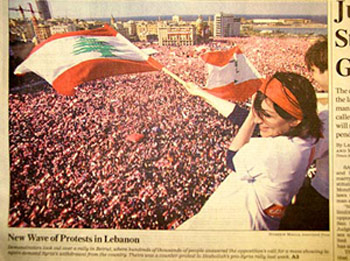
(Then)
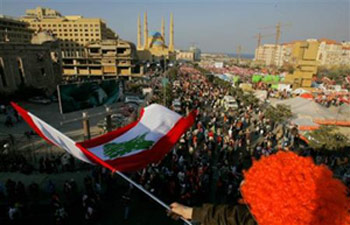
(Now)
In terms of a PR strategy, what is impressive is how Hezbollah has managed to appropriate or co-opt the iconography of last year’s Cedar Revolution.
Perhaps the signature image of the 2005 anti-Syrian uprising involved the waving of the Lebanese flag high above a crowd of pro-Democracy demonstrators. As this image circulating on this week’s newswire demonstrates, Hezbollah has taken possession of that imagery. Notice, by the way, how the Mohammed al-Amin mosque, also the subject of the NYT image above, and a key icon in the current political backdrop, is almost perfectly centered in the background.
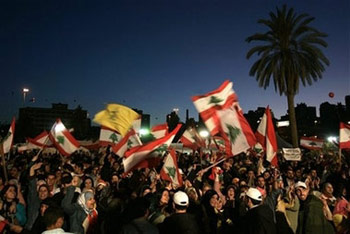
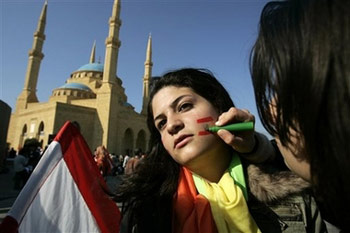
Although Hezbollah counter-demonstrators made use of the Lebanese flag last year, the state flag clearly became identified with the Christian/Druze/Secular anti-Syrian faction. Determined to neutralize that identification, if not flip it, the flag has become a high-density fixture in the Hezbollah stand off. Among Nasrallah’s followers, the icon has become ubiquitous and, in street-marketing style, is now prevalent as face paint on babies as well as body art (or war paint) on the young.
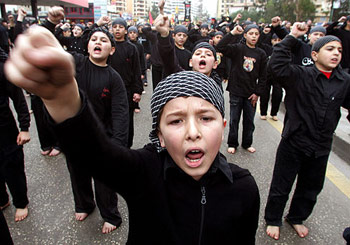
(Then)
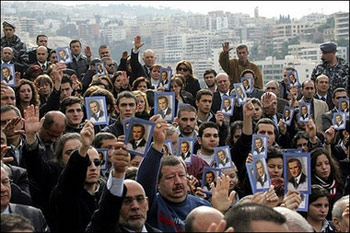
(Now)
The idea of uniformly dressed mourners holding up signs of the deceased are more typically associated with religious marches or fundamentalists wielding posters of their leaders amidst martyr photos. In a strange twist, however, the image of black-clad marching Hezbollah militants has not only disappeared, but this visual vocabulary also seems to have jumped the fence.
If you were looking for pro-Government crowd shots this week, most prominent in the coverage were images of primarly black-clad Lebanese women in head scarves holding pictures of slain former Premier Rafik Hariri outside the Government House. Similarly, there were photos like this one (above, from Tuesday) at a ceremony north of Beirut. The mourners hold photos of journalist Gebran Tueini commemorating his assassination a year ago.
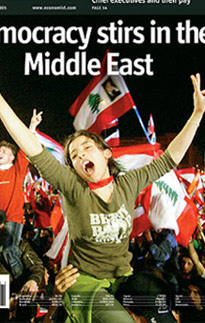
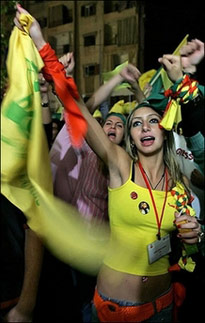
Perhaps the more obvious visual attribute of the Cedar Revolution, however, was its sexualization.
Seemingly mindful of the benefits, a lot more attractive young females are showing up in front of the cameras in support of the anti-government forces — just as (in the face painting shot above, for example), we see a modest “babe-ification” trend in the juxtaposition of attractive young Islamic activists visually married to the mosque. (If you follow the captions, however, you’ll notice the more overt “girls of the Islamic revolution” shots are coming not from the front lines, so much as from outposts of Hezbollah partners or supporters, such as student groups at Beirut’s American University.)
Along these lines, Hezbollah is making tremendous use of its recent alliance with Christian General Michel Aoun. (Aoun was part of the anti-Syrian, pro-Government coalition last year, and has since switched sides.) Through this alliance, Hezbollah and Nasrallah have been able to paint their movement/uprising as both a multicultural and a multi-denominational one. From a symbolic standpoint, the visual mileage derived has been enormous. This connection not only allows for the exploitation of more secular imagery, but also the appropriation of, and blurring of the lines between Muslim and Christian symbolism.
And exactly how might one capitalize at this time of year???
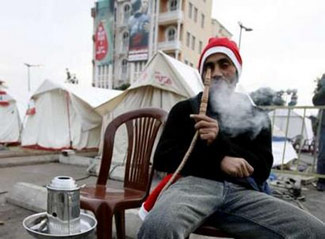
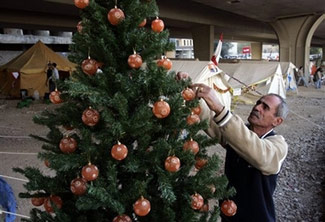
These two shots immediately above are more of a “back door view” into Hezbollah’s exploitation of Christmas.
In the first shot, a demonstrator — in front of the tents said to serve as the encampment and staging ground for Hezbollah’s occupation army — can be seen in front of a giant sign showing Condi Rice hugging Prime Minister Fuad Siniora. According to captions I’ve read (this banner, as just one more backdrop, was all over the newswire last week), the text, in English, of course, reads: “Thanks, Condi!” and is said to show dead children near the bottom.
Surveying the current crop of news photos, the encamped Hezbollah activists have turned downtown Beirut into a virtual Santa-fest. In the second shot, above, another “resident” is actually trimming a Christmas tree.
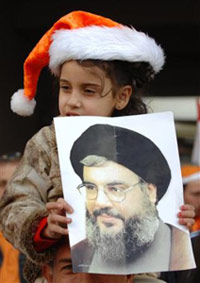
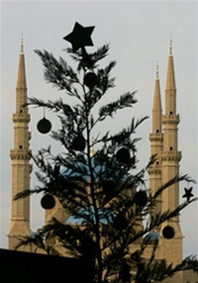
And the media result of this priming and primping?
In general, what the MSM is lapping up and spreading around right now are romantic shots like these, in which Hassan Nasrallah and Hezbollah are equated not just with holiday cheer but with sweet, cross-cultural symbolism suggesting that a Hezbollah-led government in Beirut might be a unity government, pledged to peace on earth, goodwill toward (all but Sunni) men.
(image 1: Matt Dunham/Associated Press. Beirut. December 11, 2006. nyt.com. image 2: (image: Hussein Mall/AP. Beirut. March 2005. The Los Angeles Times. image 3: unattributed. Beirut, Lebanon. December 10, 2006. Via YahooNews. image 4 & 5: Petros Giannakouris/A.P. Beirut. December 8, 2006. Via YahooNews. image 6: unattributed. March 5, 2005. salon.com. image 7: Joseph Barrak/A.P. December 12, 2006. Mkalles, Lebanon. Via YahooNews. image 8: The Economist. March 5, 2005. economist.com. image 9: unattributed. Beirut, Lebanon. December 10, 2006. Via YahooNews. image 10: Jamal Saidi/Reuters. December 12, 2006. Beirut. Via YahooNews. image 11: Hussein Malla/A.P. December 6, 2006. Beirut. Via YahooNews. image 12: unattributed. Beirut. December 10, 2006. Via YahooNews. image 13. Petros Giannakouris/A.P. Beirut. December 8, 2006. Via YahooNews.)
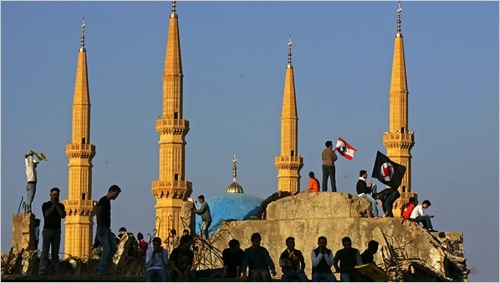
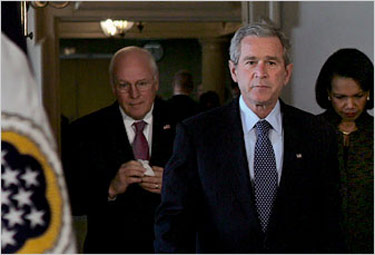
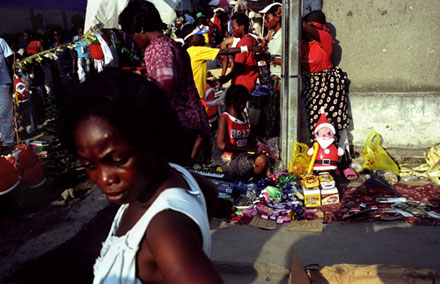
Reactions
Comments Powered by Disqus